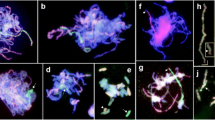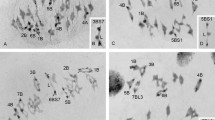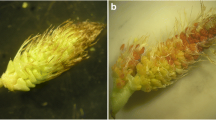Abstract
InScilla scilloides (Lindle) Druce, the heterozygotes for a pericentric inversion were found to be predominant in a small natural population consisting of cytogenetic type BB (2n=18). Pericentric inversion may include about half the length of the original subtelocentric chromosome, changing it to submetacentric. The 9II were always formed in these heterozygotes as well as in normal plants at MI in PMCs. A single chiasma was formed in the shorter one of two inverted segments divided by the kinetochore at MI, while one or two inversion chiasmata were observed in the longer segment. The AI separation was always regular. Since both arms of a normal chromosome and those of an inverted one were clearly distinguishable from one another at AI and AII, two kinds of crossover chromatids could be identified. Both sides of the single inversion chiasma always opened out reductionally. The frequency of bivalent without inversion chiasma agreed statistically with that of half-bivalent at AI or chromatid structure at AII, which resulted from non crossing-over within the inverted segment. Likewise, no statistical difference was found between the frequency of a single chiasma and that of a single crossing-over product in a longer inverted segment. These findings have clearly proved that the chiasma is a consequence of genetic crossing-over. The average proportion of good pollen grains in the inversion heterozygotes, 53.6%, amounted to about half that of normal plants, 97.7%.
Similar content being viewed by others
References
Brown, S.W. andD. Zohary. 1955. The relationship of chiasmata and crossing over in Lilium formosanum. Genetics40: 850–873.
Darlington, C.D. 1937. Recent Advances in Cytology. 2nd ed. Churchill, London.
Giles, N.H. Jr. 1944. A pericentric inversion inGasteria resulting in apparent iso-chromosomes at meiosis. Proc. Nat. Acad. Sci.30: 1–5.
Haga, T. 1944. Meiosis inParis. I. Mechanism of chiasma formation. Mem. Fac. Sci. Hokkaido Imp. Univ. Ser. V, Bot.5: 121–198.
Henderson, S.A. 1970. The time and place of meiotic crossing-over. Ann. Rev. Genet.4: 295–324.
John, B. andK.R. Lewis. 1965. The Meiotic System. Protoplasmatologia 6, Fl. Springer-Verlag, Wien and New York.
Morgan, D. Th. Jr. 1950. A cytogenetic study of inversions inZea mays. Genetics35: 153–174.
Noda, S. 1967. Chiasma studies in structural hybrids. VIII. Further evidences for chiasma formation by crossing-over in reciprocal translocations ofScilla scilloides. Japan. J. Genet.42: 89–93.
— andH. Watanabe. 1968. Chromosome constitutions and polymorphic B-chromosomes inAllium thunbergii (A preliminary note). Bull. Osaka Gakuin Univ.11: 105–128.
— 1972. Samplings in the natural populations ofScilla scilloides (II). Bull. Osaka Gakuin Univ.18: 227–249.
Nur, U.. 1968. Synapsis and crossing over within a paracentric inversion in the grasshopper,Camnula pellucida. Chromosoma (Berl.)25: 198–214.
Sannomiya, M. 1968. Chiasma studies in structural hybrids. X. Further studies inAcrida lata. Japan. J. Genet.43: 103–108.
Sansome, E.R.. 1932. Segmental interchange inPisum sativum. Cytologia3: 200–219.
Sjödin, J. 1971. Induced paracentric and pericentric inversions inVicia faba L. Hereditas67: 39–54.
Smith, S.G. 1935. Chromosome fragmentation produced by crossing-over inTrillium erectum L. J. Genet.30: 227–232.
Walters, J.L. 1952. Heteromorphic chromosome pairs inPaeonia californica. Amer. J. Bot.39: 145–151.
Watanabe, H. and S. Noda. 1974. Chiasma studies in structural hybrids. XI. Pericentric inversion inAllium thunbergii. Nucleus (in press).
White, M.J.D. 1951. Structural heterozygosity in natural populations of the grasshopperTrimerotropis sparsa. Evolution5: 376–394.
— 1956. Adaptive chromosomal polymorphism in an Australian grasshopper. Evolution10: 298–313.
— 1961. Cytogenetics of the grasshopperMoraba scurra. Aust. J. Zool.9: 784–790.
—F.H.W. Morley. 1955. Effects of pericentric rearrangements on recombination in grasshopper chromosomes. Genetics40: 604–619.
Whitehouse, H.L.K. 1969. Towards an Understanding of the Mechanism of Heredity. 2nd ed. Edward Arnold, London.
Zohary, D. 1955. Chiasmata in a pericentric inversion inZea mays. Genetics40: 874–877.
Author information
Authors and Affiliations
Rights and permissions
About this article
Cite this article
Noda, S. Chiasma studies in structural hybrids IX. Crossing-over in pericentric inversion ofScilla scilloides . Bot Mag Tokyo 87, 195–208 (1974). https://doi.org/10.1007/BF02489296
Received:
Issue Date:
DOI: https://doi.org/10.1007/BF02489296




